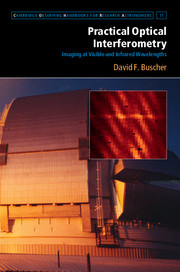Book contents
- Frontmatter
- Contents
- Principal symbols, functions and operators
- List of abbreviations
- Foreword
- Preface
- 1 Making fringes
- 2 Basic imaging
- 3 Atmospheric seeing and its amelioration
- 4 Interferometers in practice
- 5 Measurement noise
- 6 Interferometric observation of faint objects
- 7 Observation planning
- 8 Data reduction
- 9 Model fitting and image reconstruction
- Appendix A Fourier transforms
- Appendix B Supplementary online material
- References
- Index
6 - Interferometric observation of faint objects
Published online by Cambridge University Press: 05 August 2015
- Frontmatter
- Contents
- Principal symbols, functions and operators
- List of abbreviations
- Foreword
- Preface
- 1 Making fringes
- 2 Basic imaging
- 3 Atmospheric seeing and its amelioration
- 4 Interferometers in practice
- 5 Measurement noise
- 6 Interferometric observation of faint objects
- 7 Observation planning
- 8 Data reduction
- 9 Model fitting and image reconstruction
- Appendix A Fourier transforms
- Appendix B Supplementary online material
- References
- Index
Summary
The ability to observe faint objects is a key requirement for an astronomical instrument. Many types of object are intrinsically rare and therefore the closest examplars are far away and hence faint. For objects which are less rare, being able to ‘go fainter’ means that more exemplars of the class can be studied to give statistical validity to any findings.
The exposure times used in interferometry are typically much less than those used in other types of astronomical instruments – usually milliseconds instead of minutes or hours. As a result, a target which would be considered bright for many astronomical observations is considered faint in interferometric terms. This means that the majority of potential astronomical targets are likely to be in the faint-object regime for interferometry, because they will have been discovered using techniques which have intrinsically better faint-object sensitivity.
This chapter takes a quantitative look at the limitations of interferometry when observing faint objects. It looks at the trade-offs involved in adjusting the parameters of an interferometric observation such as the exposure time, with the aim of (a) determining the best parameter settings to use for observing faint objects and (b) determining the faintest possible object which can be observed under a given set of conditions.
Adaptive optics (AO) systems can be used to increase the signal-to-noise ratio (SNR) for an interferometric measurement, because they allow the use of a large-aperture telescope while ameliorating the negative effects of atmospheric wavefront errors on interferometric SNRs. In the same way, cophasing fringe trackers allow the use of long exposure times to improve the SNR of observations of faint objects.
Unfortunately, it is precisely on faint objects that the assumption that the atmospheric correction provided by active correction systems such as AO and fringe trackers breaks down. These systems need a sufficient number of photons from a reference object to accurately sense the wavefront perturbations, and the reference object is typically the object under study itself. If the object being studied does not provide enough photons then the level of correction will be worse, degrading the SNR of interferometric measurements, which were already low due to the faintness of the source.
- Type
- Chapter
- Information
- Practical Optical InterferometryImaging at Visible and Infrared Wavelengths, pp. 152 - 179Publisher: Cambridge University PressPrint publication year: 2015



